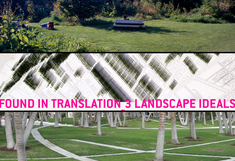FOUND IN TRANSLATION: 3 Landscape Ideals
Landscape practice, based on systemic readings and operations, engages both physical context and time. We co-opt fluxes of water, vegetation, infrastructure, and humans across site boundaries, and project across seasons and decades. Yet, when teaching design we typically rely on the contemporary and immediate past for case studies, as if projects were indelibly marked by their social raison d’être at the time of creation. This paper tracks three landscape ideals across time and space. I will examine the notion of terrain—both physical and professional—from the late nineteenth century to today in a series of key moments and movements. Attitudes toward vegetation and topography, which are typically considered the keystone of landscape expertise, ultimately express strategies for spatial and emotional place-making. Thus when William Robinson advocated for the wild garden in 1870, he also staked a territory that was professional (against architects), geo-political (the British Empire), and poetic (the feeling for Englishness). Fifty years later, Danish landscape architect G.N. Brandt revised the wild garden to counter the achitektonische Garten and provide space for the imagination. Today, Robinson’s aesthetic and ethical process of naturalness can be re-evaluated against the planting theories of Gilles Clément’s jardin en mouvement or Piet Oudolf’s perennial movement. Likewise, the bulbous shapes of Michel Corajoud’s 1970s parks can find echo in George Hargreaves’s sculptural landforms or West 8’s micro-topographies. Finally, the tree patterns of Garrett Eckbo’s depression-era camps and postwar housing belie a desire to hold space with simple means, anticipating the territorial and urban forestry of Michel Desvigne. This viewing of contemporary projects through the lens of time doesn’t so much reveal the genesis of concepts as it does underscore the resilience of landscape ideals—simultaneously essential and complex. Dorothée Imbert chairs the Master of Landscape Architecture Program and is a Professor at Washington University in St. Louis. She was trained as an architect and a landscape architect in Paris and at the University of California at Berkeley. She practiced landscape architecture at Peter Walker and Partners from 1996 until 1999 and subsequently taught at Harvard University for ten years before joining the faculty at Washington University. Imbert has carried out extensive research on landscape modernism with an emphasis on Europe and California, leading to the books The Modernist Garden in France (Yale, 1993), Garrett Eckbo: Modern Landscapes for Living, co-authored with Marc Treib (California, 1996, 2005), and Between Garden and City: Landscape Modernism and Jean Canneel-Claes (Pittsburgh, 2009). She is currently editing a volume on Food and the City for Dumbarton Oaks, where she organized a symposium on productive landscapes and the urban context in May 2012. Her recent design and research interests have centered on the intersection of urban interventions and the definition of productive landscapes. The project “Parking Plot,” carried out with Paula Meijerink and the students of Washington University, was included in the US pavilion’s exhibition Spontaneous Interventions: Design Actions for the Common Good at the 2012 Venice Architecture Biennale http://www.spontaneousinterventions.org/

